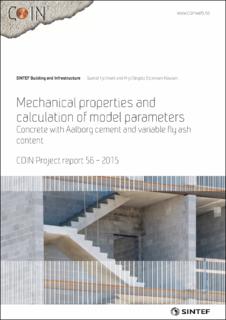| dc.description.abstract | One of the objectives of COIN's Focus Area 3.1 Crackfree concrete structures is to develop guidelines for recommended mix design for different types of structures subjected to restrained thermal dilation and autogeneous shrinkage. FA 3.1 should develop further the theoretical and practical implications of crack control by stress calculation, aiming at full incorporation of the technology in the specification for civil engineering structures.
As part of this research, experiments with two different concretes containing Aalborg cement and variable amount of fly ash have been carried out within the project. This was conducted as a supplement to the previous experiments with Norcem cements performed and reported earlier within the same COIN project.
This report contains a detailed description of the materials and the test methods used in the experimental programme, and presents the results from this mechanical test programme for the two concrete qualities in question.
The mechanical test programme covers fresh concrete properties; slump, density and air content, tested according to NS-EN 12350, Part 2, 6 and 7. Further, it covers testing of the following hardened concrete properties:
- Density and compressive strength, NS-EN 12390, Part 7 and 3
- Modulus of elasticity in compression (NS 3676), and tension
- Uniaxial tensile strength, SINTEF internal procedure 14-05-04-512
- Splitting tensile strength, NS-EN 12390-6
- Activation energy, NS 3656:1993
- Heat development, NS 3657
In general, it is shown that all the investigated properties; the final heat generated, the compressive strength, the tensile strength and the E-modulus decrease approximately linearly with increasing FA content.
The material models used for the heat development and the time dependence of the mechanical properties are described. Furthermore are the model parameters determined for the investigated concretes. In general, the material models describe the test results very well. The model parameters are logically related to the FA content, and confirm previous experience.
The calculated material model parameters will be implemented in the material data base for the temperature and stress calculation program Crack TeSt COIN. | |
